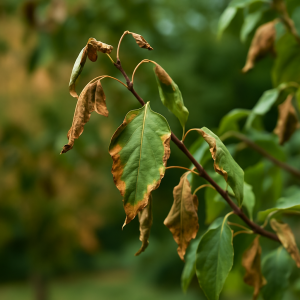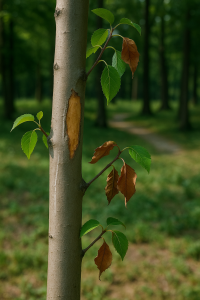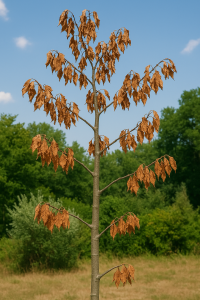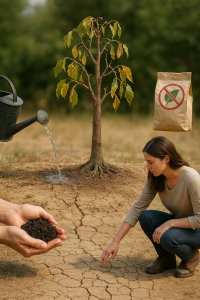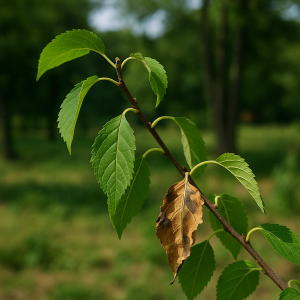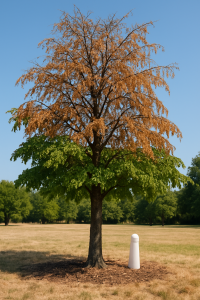As summers grow hotter in British Columbia, trees are becoming increasingly vulnerable to a silent but serious threat: heat stress. Unlike dramatic events like windstorms or pest infestations, heat stress creeps in slowly, and if left unchecked, it can weaken trees, stunt their growth, and even lead to permanent damage.
Whether you’re a homeowner trying to protect your yard or a property manager responsible for a commercial landscape, recognizing the signs early and taking action is key to keeping your trees thriving through the heat.
What Is Heat Stress in Trees?
Heat stress occurs when trees experience prolonged exposure to high temperatures, especially when combined with dry soil conditions. While many trees are adapted to handle some heat, extended periods of intense sun, low humidity, and limited water availability can throw their systems out of balance.
In regions like southern Vancouver Island or the Okanagan, where summer temperatures can climb quickly and rainfall may be inconsistent, even native trees can begin to show signs of stress.
Signs and Symptoms of Heat Stress
Keep an eye out for these telltale signs that your trees may be struggling with the heat:
-
Wilting or drooping leaves — Even in the early morning, leaves may look limp or curled.
-
Leaf scorch — This shows up as brown, crispy edges around leaves, especially in broadleaf species.
-
Premature leaf drop — Some trees may begin shedding leaves in midsummer to conserve water.
-
Sunburn on bark — On young or thin-barked trees, you may notice pale patches or peeling bark where intense sun exposure occurs.
-
Stunted growth — Trees under stress may produce smaller-than-usual leaves or fewer buds and shoots.
-
Dull or faded leaf colour — A general lack of vibrancy may indicate a lack of proper hydration and energy.
These symptoms can show up gradually, so monitoring your trees throughout the summer, not just during heat waves, is important.
Heat Stress vs. Drought or Disease: Know the Difference
Heat stress and drought often go hand-in-hand, but they’re not exactly the same. Drought primarily results from a lack of water in the soil, while heat stress includes the additional factor of extreme temperatures, which can impair a tree’s internal processes, even when water is technically available.
Diseases or pest damage can sometimes mimic heat stress symptoms, such as leaf discoloration or drop. One key difference? Heat stress tends to affect the entire tree uniformly, while disease often appears in patches or isolated branches.
If you’re unsure, look at the pattern: is the whole tree suffering, or is it just one section? For persistent issues, it’s worth consulting a certified arborist.
How to Prevent Heat Stress in Trees
Proactive care is the best way to help your trees survive and thrive during BC’s hot, dry months.
1. Water Deeply, But Infrequently
Instead of frequent light watering, give trees a slow, deep soak every 7–10 days during hot weather. Aim for early morning or late evening watering to reduce evaporation. Soaker hoses or drip systems are ideal.
2. Mulch Wisely
A 2- to 4-inch layer of organic mulch (like wood chips or bark) around the base of the tree helps retain soil moisture, regulate temperature, and reduce weed competition. Keep mulch a few inches away from the trunk to prevent rot.
3. Protect Young and Vulnerable Trees
Saplings and newly planted trees are particularly sensitive to heat stress. Use tree wraps or temporary shade cloths during extreme heat spells, and make sure they have consistent access to water.
4. Avoid Pruning During Heat Waves
Pruning during high heat can expose tender inner branches to sun damage and further stress the tree. If needed, prune in late winter or early spring when conditions are milder.
What to Do If a Tree Is Already Stressed
If you suspect a tree is suffering from heat stress, don’t panic—but do take immediate steps to support recovery.
✔️ Hydrate Properly
Ensure the tree is getting adequate water. Use the “slow soak” method to rehydrate the root zone, especially during dry spells.
✔️ Hold Off on Fertilizer
Avoid fertilizing stressed trees. Fertilizer encourages new growth, which the tree may not be able to support during a heat wave.
✔️ Improve Soil Health
Compacted or poor-quality soil can limit root access to water. To increase moisture retention, consider aerating around the tree or amending the soil with compost.
✔️ Stay Patient
Trees are resilient, but they take time to recover. Until the weather cools, continue monitoring leaf condition, water regularly, and avoid unnecessary disruptions.
Looking Ahead
As climate patterns continue to shift, it’s becoming more important than ever to recognize how our urban and natural landscapes respond to extreme weather. In BC, where trees are integral to both property value and ecological health, understanding how to identify and respond to heat stress is a critical part of long-term tree care.
By staying observant and responsive, you can ensure your trees not only survive the summer but also stand tall for seasons to come.
